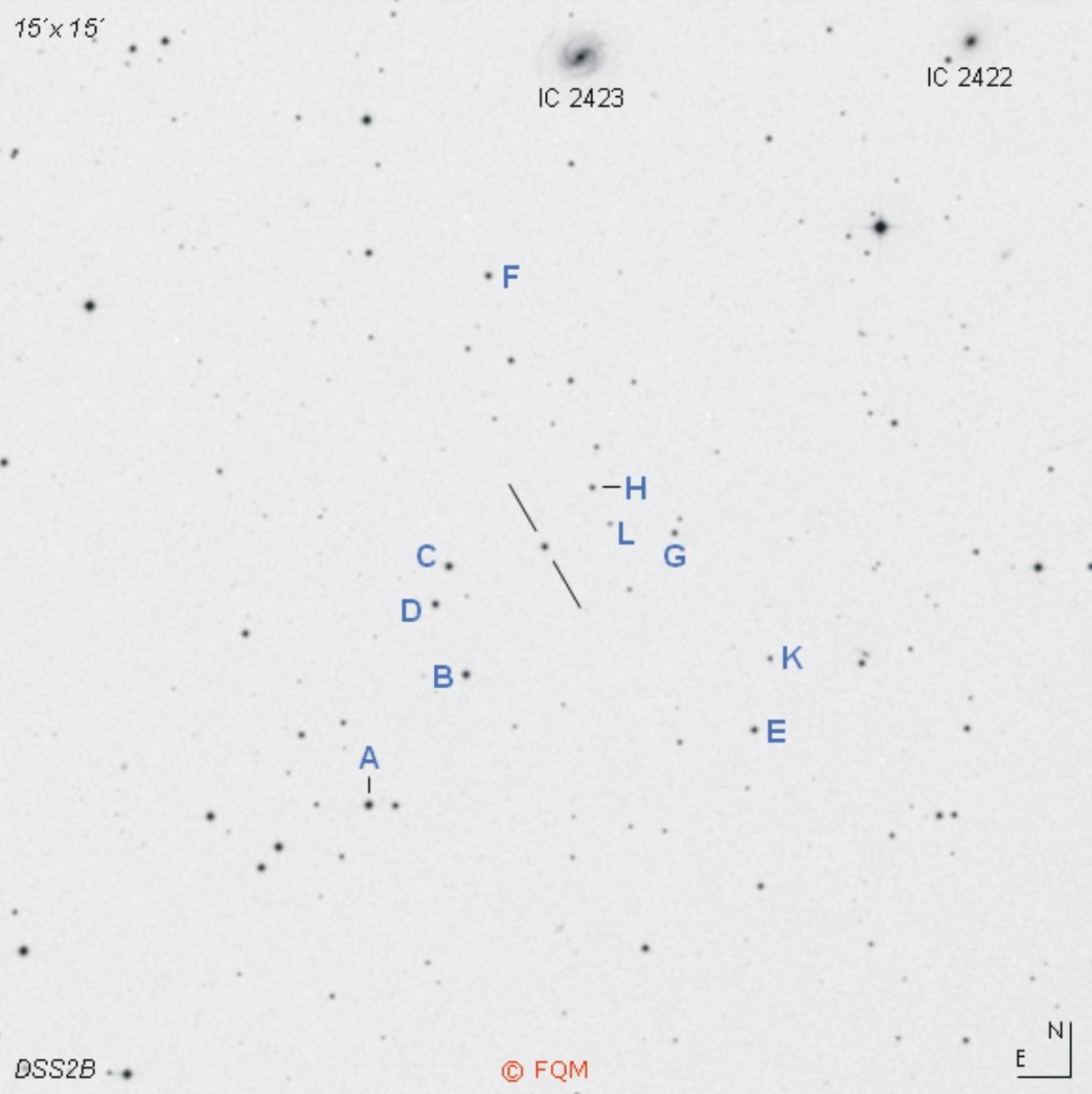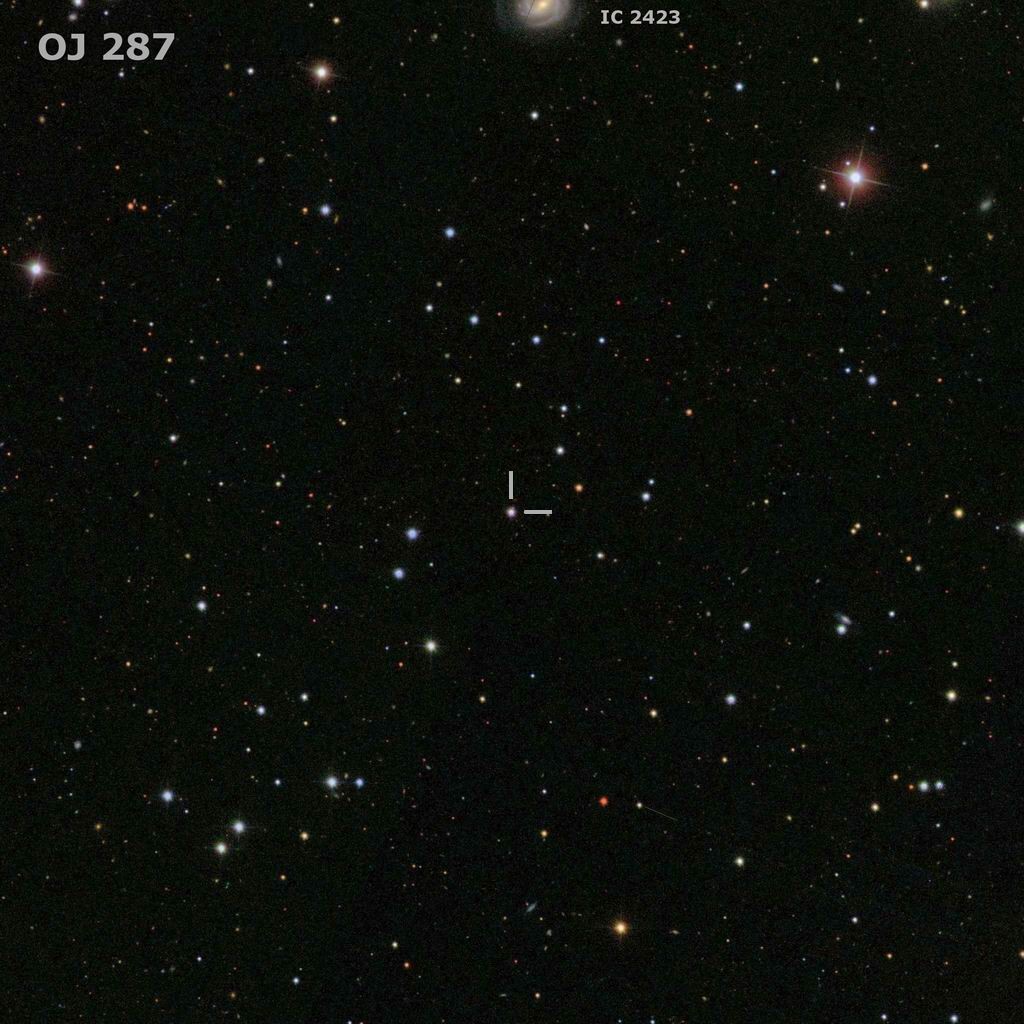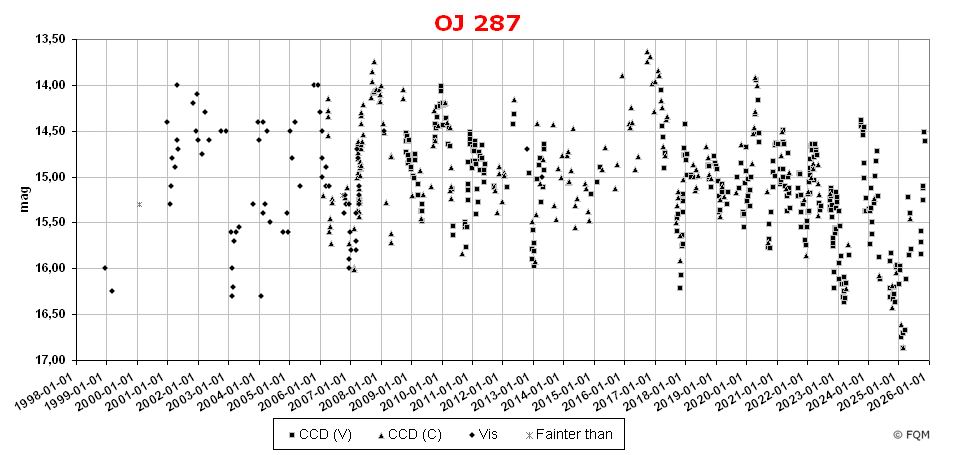
| Frankfurt Quasar Monitoring |
| OJ 287 |
| Cross-Identifications | PG 0851+202, PKS 0851+202, VRO 20.08.01 GC 0851+20, B2 0852+20, IRAS 08519+2017 1ES 0851+203, RX J0854.8+2006, 0851+202 SDSS J085448.87+200630.7, 3EG J0853+1941 2MASX J08544889+2006307, VSOP J0854+2006 QSO J0854+2006, QSO B0851+202, OJ +287 1RXS J085451.5+200646, RGB J0854+201 |
| Equat. coordinates | RA 08 54 48.8 DE +20 06 30 (J2000) |
| Constellation | Cancer |
| Type | BL Lac |
| Redshift (1) | z=0.306 |
| Distance (2) (3) | 1176 Mpc |
| Total mag range (mv) (4) | 12.0 - 17.5 |
| Catalog Magnitude (1) | 15.43 |
| Absolute Magnitude (1) | -25.5 MB |
| Light Travel-Time (2) | 3.357 × 109 yrs |

Comparison stars
| star | B | V | Rc | Ic |
| A | 14.6102 | 13.9862 | 13.6362 | 13.2932 |
| B |
--- | 14.181 | 13.741 | 13.281 |
| C | --- | 14.601 | 14.341 | 14.031 |
| D | --- | 14.941 | 14.651 | 14.321 |
| E | 15.8912 | 15.2032 | 14.7982 | 14.4082 |
| F | --- | 15.3822 | 15.0332 | --- |
| G | --- | 15.881 | 15.501 | 15.081 |
| H | --- | 16.121 | 15.661 | 15.211 |
| K | 17.2092 | 16.5412 | 16.1342 | 15.7342 |
| L | 18.4972 | 17.0622 | 16.0892 | 15.0822 |


| OJ
287 is a
violently variable BL Lac object in
Cancer and is also one
of the best-studied objects of its kind.
This BL Lac
object displays
extremely large and rapid flux variations at both radio and optical
wavelengths with
variability time-scales varying
from minutes to years - a typical OVV.
OJ 287 is very
active with a total optical variability of more than 5 mag, showing
large optical outbursts.
Together with its high
degree of polarization, this object was classified as a BL Lac
object.
The designation OJ 287 derives from the radio survey of the Ohio State
University (OJ), where this object was cataloged as a radio source. Initially, the
radio source was discovered in the mid 1960s by both the
Vermillion River Observatory radio survey (VRO) at 610.5 MHz and the
Ohio radio survey (OJ) at 1415 MHz. The most interesting feature about OJ 287 is its optical behaviour. Light curves of former monitoring programmes revealed outbursts with a period of approximately 12 years in the optical and in the infrared. Each outburst is described by a twin-peak structure. This unusual periodicity is explained by the model of a precessing binary black hole, consisting of two supermassive black holes with 18×109 solar masses for the primary and 1.5×108 solar masses for the secondary black hole. According to this model, the secondary black hole is moving around the primary on a highly eccentric orbit, perturbing the accretion disk of the primary during pericenter passages, once every 12 year orbital cycle. International multi-wavelength monitoring programmes during the predicted outbursts in 1993/94 (OJ-94 project) and 2005/07 confirmed this model. The author participated in the 2005/07 Pro-Am observing campaign. The latest predicted outburst of OJ 287 occured in November–December 2015, coinciding with the centenary of General Relativity. In the case of OJ 287, the tremendous gravitational field of the larger black hole causes the smaller black hole’s orbit to precess at an incredible 39° each orbit, as predicted by Einstein’s theory of general relativity. "Its (OJ 287) light curve is definitely not periodic but the deviations from periodicity are systematic and predictable in a model that contains a gravitational wave driven inspiralling spinning binary black hole system as its central engine" (Valtonen et al. 2016). Due to the loss of orbital energy by gravitational radiation the two black holes will merge within the next 10,000 years. ____________
For
both visual and CCD observers, OJ 287 is an interesting target at any
time. During brighter state, visual observers with telescopes of 8- to
10-inch of aperture and larger will have no difficulties to spot
this blazar. Visually, OJ 287 remains a stellar object even with large
apertures. CCD observers as well as visual observers may use the
comparison stars given above. Other photometric
sequences were published by Penston et al. (1973), Craine et al.
(1975), Veron et al. (1975), McGimsey et al. (1976), Smith et al.
(1985), and the BAAVSS - which underlines the high astrophysical
interest regarding this very special AGN. Observers who like to continue their observing session with more quasi-stellar photons may turn to quasar PG 0844+349, a bright 14-mag object at a distance of about 0.8×109 light-years, located some 14° N of OJ 287. Another violently variable BL Lac object is PKS 0754+100, which lies some 17.3° SW of OJ 287, at a distance of about 3×109 light-years. When you are around for OJ 287 with your telescope, do not forget to visit open cluster M44, the "beehive cluster", about 3° E of OJ 287. Some 1.6° to the SW you find the interacting galaxy pair NGC 2672/73 (Arp 167). Variable star observers may like to take a look at carbon star T Cnc (var. 7.6-10.5 mag), only 30´SE of OJ 287. Its vivid reddish colour is a nice catch for medium sized telescopes. |
| Blake, G.M. 1970, ApL, 6, 201;
Observations of Extragalactic Radio Sources having unusual Spectra. Corso, G.J., Ringwald, F., Schultz, J. 1988, PASP, 100, 70; Blue-Light Monitoring of 3C 273, 3C 351, 3C 454.3, 3C 66A, PKS 2141+17, OJ 287 and ZE 0039.5+04. Craine, R.E.; A Handbook of Quasistellar and BL Lacertae Objects; Parchart Publishing House, Tuscon 1977. Cruz-Gonzales, I., Huchra, J.P. 1984, AJ, 89, 441; Continuum Distributions of a X-ray observed Sample of BL Lac Objects. Dickel, J.R., Yang, K.S., McVittie, G.C., Swenson, G.W., Jr. 1967, AJ 72, 757; A survey of the sky at 610.5 MHz. II. The region between declinations +15 and +22 degrees. Dixon, R.S., Kraus, J.D. 1968, AJ, 73, 381; A High-Sensivity 1415 MHz Survey at North Declinations between 19 and 37 degrees. Fiorucci, M., Tosti, G. 1996, A&AS, 116, 403; VRI Photometry of Stars in the Fields of 12 BL Lacertae Objects. Gaida, G., Röser, H.J. 1982, A&A, 105, 362; The Photometric History of the BL Lacertae Object OJ 287. Gonzàlez-Pérez, J.N., Kidger, M.R., et al. 2001, AJ, 122, 2055; Optical and Near-Infrared Calibration of AGN field stars: An All-Sky Network of faint Stars calibrated on the Landolt System. Haikala, L. 1983, SuW 3/83, 111; OJ 287: Ein periodisch veränderliches BL-Lac-Objekt. Hansen, T. 1991, Deep Sky Magazine 34, 32; The "Deepest" Deep Sky Objects. Harrington, P. 1994, Astronomy 6/94, 56; Tracking down a Quasar. Karge, S. 2002, Interstellarum 22, 8; Der extragalaktische Variable OJ 287. Karge, S.; Helle Quasare für 8- bis 10-Zoll Teleskope. Ein Beobachtungsführer zur visuellen Beobachtung von Quasaren und BL Lacertae Objekten; Frankfurt 2005. Kasper, M. 1997; SuW 12/97, 1029; Schwarzes Doppelloch. Katajainen, S., Takalo, L.O., et al. 2000, A&AS, 143, 357; Tuorla Quasar Monitoring. I. Observations of 1995-1997. Kinman, T.D. 1976, ApJ, 205, 1; Photoelectric Magnitudes and Polarization Data for possible BL Lacertae Objects. Lehto, H.J., Valtonen, M.J. 1996, ApJ, 460, 207; OJ 287 Outburst Structure and a Binary Black Hole Model. Lloyd, C. 1984, MNRAS, 209, 697; Optical Monitoring of Radio Sources. McGimsey, B.Q., Miller, H.R., Williamon, R.M. 1976, AJ, 81, 9; Photoelectric UBV Sequences in the Fields of Extragalactic Sources. Miller, J.S., French, H.B., Hawley, S.A. 1978, in: Pittsburgh Conference on BL Lac Objects, A.M. Wolfe (ed.), p.175. Owen, F.N., Porcas, R.W., et al. 1978, AJ, 83, 685; Observations of Radio Sources with Flat Spectra. Pollock, J.T., Pica, A.J., et al. 1979, AJ, 84, 11; Long-term optical Variations of 20 Violently Variable Extragalactic Radio Sources. Puschell, J.J., Stein, W.A. 1980, ApJ, 237, 331; Observations of strongly polarized Extragalactic Sources. Selmes, R., Tritton, K., Wordsworth, R. 1975, MNRAS, 170, 15; Optical Monitoring of Radio Sources - IV. Results up to 1973 April. Sillanpää, A., Haarala, S., et al. 1988, A&AS, 72, 347; Optical Monitoring of Quasars and BL Lac Objects. Sillanpää, A., Haarala, S., et al. 1988, ApJ, 325, 628; OJ 287: Binary Pair of Supermassiv Black Holes. Sillanpää, A., Mikkola, S., et al. 1991, A&AS, 88, 225 ; Optical Monitoring of Quasars and BL Lacertae Objects. II. Smith, P.S., Balonek, T.J., et al. 1985, AJ, 90, 1184; UBVRI Field Comparison Stars for Selected Active Quasars and BL Lacertae Objects. Steinicke, W.; Katalog heller Quasare und BL Lacertae Objekte; Umkirch 1998. Steinicke, W.; Beobachtungsliste für helle Quasare; Umkirch 1999. Stickel, M., Fried, J.W., Kühr, H. 1989, A&AS, 80, 103; Optical Spectroscopy of 1 Jy BL Lacertae Objects and Flat Spectrum Radio Sources. Stull, M.A. 1973, Sky & Telescope, Vol. 45, 4/73, 224; Two Puzzling Objects: OJ 287 and BL Lacertae. Ulrich, M.-H., Maraschi, L., et al. 1997, Ann. Rev. Astr. Ap., 35, 445; Variability of Active Galactic Nuclei. Valtonen, M., Kidger, M., Lehto, H., Poyner, G. 2008, A&A, 477, 407-412; The Structure of the October/November 2005 Outburst in OJ287 and the Precessing Binary Black Hole Model. Valtonen, M.J., Lehto, H.J., Takalo, L.O., Sillanpaa, A. 2011, ApJ 729, 33; Testing the 1995 Binary Black Hole Model of OJ287. Valtonen, M.J., Ciprini, S., Lehto, H.J. 2012, MNRAS 427, 77; On the masses of OJ287 black holes. Valtonen, M.J., Zola, S., et al. 2016, ApJ 819L, 37; Primary Black Hole Spin in OJ 287 as Determined by the General Relativity Centenary Flare. Véron, P., Véron, M.P. 1975, A&A, 39, 281; Photographic Photometry of Five BL Lacertae-type Objects. Véron-Cetty, M.-P., Véron, P. 1998, ESO Scientific Report 18; A Catalogue of Quasars and Active Nuclei (8th Edition). Véron-Cetty, M.-P., Véron, P. 2000, ESO Scientific Report 19; A Catalogue of Quasars and Active Nuclei (9th Edition). Véron-Cetty, M.-P., Véron, P. 2001, A&A 374, 92; A Catalogue of Quasars and Active Nuclei: 10th edition. Véron-Cetty, M.-P., Véron, P. 2003, A&A 412, 399; A Catalogue of Quasars and Active Nuclei: 11th edition. Véron-Cetty, M.-P., Véron, P. 2006, A&A 455, 776; A Catalogue of Quasars and Active Nuclei: 12th edition. Véron-Cetty, M.-P., Véron, P. 2010, A&A 518, 10; A Catalogue of Quasars and Active Nuclei: 13th edition. Webb, J.R., Smith, A.G., et al. 1988, AJ, 95, 374; Optical Observations of 22 Violently Variable Extragalactic Sources: 1968-1986. Weistrop, D., Shaffer, D.B., et al. 1985, ApJ, 292, 614; Optical and Radio Observations for the BL Lacertae objects 1219+28, 0851+202, and 1400+162. Wenzel, K. 1997, Interstellarum 10, 25; Quasare - Objekte für den visuell beobachtenden Amateur. Wenzel, K. 2002, Interstellarum 20, 56; OJ 287 - ein schwarzes Doppelloch. Wenzel, K., Düskau, W. 2003, SuW 2/03, 60; BL-Lacertae-Objekte - Eine Herausforderung für den Amateur. Xie, G.Z., Li, K.H., et al. 1990, A&A, 229, 329; Search for short Variability Time-scales of BL Lacertae Objects. |
| Links: Landessternwarte Heidelberg Hamburg Quasar Monitoring AAVSO Gary Poyner (light curve) Sloan Digital Sky Survey |
| home |